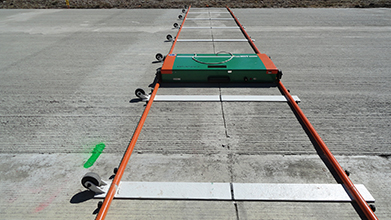Dowel Bar Alignment
Using Pulse Induction Technology
MIT Scan-2 is a state-of-the-art, nondestructive testing device for measuring the position of dowel bars embedded in concrete. The operating principle behind the device is pulse-induction. The equipment emits a weak, pulsating, magnetic signal and detects the transient magnetic response signal induced in metal bars. The response signals are measured with high precision using special receivers in the testing device, permitting the determination of horizontal misalignment, vertical misalignment, side shift and depth of the dowel bar from the top of the pavement.
Proper dowel bar alignment is essential for efficient load transfer between concrete pavement slabs. Until the advent of this device, there was no way of accurately checking alignment of dowel bars other than taking cores (which can be only done on a limited basis). The advantage with MIT Scan 2 is it can be used as soon as the pavement can be walked upon to check the presence and alignment of dowel bars, allowing the contractor to take corrective action immediately. Typically, coring is not conducted unless dowel bar placement issues are suspected. Even in those cases, coring is not a good method to check the presence and alignment of dowel bars, since coring can be performed at only a limited number of joints. In addition, multiple cores have to be taken at each joint, since taking one or two cores will not reveal the overall dowel bar alignment at a joint.
The major benefits of MIT Scan 2 are that it is nondestructive, measurement can be taken extremely quickly (two to five minutes per joint), results can be seen in a graphical display or a tabular format immediately in the field for quality control purposes, and it is not very complicated to operate. Currently North Carolina DOT, Nevada DOT, and the New York Thruway Authority, have specified the use of this technology to check alignment of dowel bars in their specifications.
Properly aligned and embedded dowel bars are vital for load transfer in jointed plain concrete pavements. Significantly misaligned dowels may lead to joint locking which can cause slabs to crack. Improper placement (embedment) of dowels leads to decrease in load transfer efficiency, which can result in faulting and other pavement distresses. See NCHRP Report 637 Guidelines for Dowel Alignment in Concrete Pavements for more detailed information. MIT Scan 2 is a very effective tool specifically designed to non-destructively identify the presence and alignment of dowel bars at a joint and provide information during construction to agencies and contractors.


